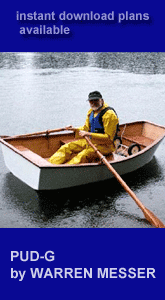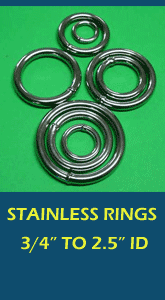The spark that got me started in designing and building a stretched version of the Optimist sailing pram took place in my garage on a New Year's Eve about eight years ago. Several of us at our annual New Year's Eve party were out in the garage, drinks in hand, admiring myoid Optimist built about 1963 by a boat builder in Lake Geneva, WI. No doubt the boat was made of garden variety marine plywood and Resorcinol glue and is still in great shape here in 2015.
I was saying how much I enjoyed sailing the Optimist but wished that it would be just a tad larger so that it would more comfortable and possibly occasionally fit another person. One of the guys mentioned that he had built a kayak out of foam board, fiberglass cloth and polyester resin. That comment planted the seed. Several years later when well into retirement, I could see the handwriting on the wall that our sailing days in the trusty Catalina Capri 18 were coming to an end and that I needed to find a smaller boat for sailing solo. After months of scanning Craigslist, I found an eleven foot sloop rigged used sailboat 300 miles to the north in the Chicago area. It looked like the perfect solution. However, at the last minute, I got to thinking: would a 140 pound man in his mid-70's really want to step a sixteen foot mast every time that he went sailing for an hour or two in the local lake about fifteen minutes away? That got me to thinking about the simplicity of the Optimist sprit rig.
Research on the internet indicated that surfboard builders were increasingly going to polystyrene and epoxy construction for the strength and durability. I toured the local hardware stores and found that Dow blue polystyrene structural insulation board was available in 4' by10' sheets and a thickness of 0.55", just right for a not quite 10 foot boat. The product was also closed cell which should not absorb water to any extent. It was also bendable without breaking and should conform to the curves of a sailboat. Now the basics were settled. The boat would have a wood skeleton covered with polystyrene
(chemically: polyisocyanurate) and that skin covered with fiberglass cloth and epoxy inside & out.
The next step was to do the scale up drawings from the 7' 9" LOA Optimist to an LOA of 9' 6". The beam was also increased as much as possible without having the boat bottom exceed the width of the poly sheet. This turned out to be a beam of 57" for the new design versus 44" on the Optimist. It did not take long to realize that doing the drawings in feet and inches was becoming a nightmare. Converting to metric solved this bump in the road. The next step was to build a 1/10th scale model and this was facilitated by using metric dimensions, as the same drawing could be used for both the model and the full scale boat by just switching from centimeters to millimeters.
The model was made of thin cardboard complete with sails of paper. The model greatly facilitated visualizing the sail plan and sizing the bowsprit. It also helped to avoid making errors later on the full scale boat. I. E., building of the boat building needed to be started with the bottom up and the gunnels clamped to 3 very level sawhorses to insure that the top of the boat was all in one straight plane.
Since I had little in the way of wood working equipment and had always wanted a table saw, I went out and bought one. My son loaned me a chop saw for cutting miters and angles. The learning curve was slow at first but turned up quickly after a few minor errors. Construction step 1 was to construct a wood skeleton mostly out of 1" by 2" stringers and a keel board of a 1" by 8", all in pine. In order to impart a curve to these 10 foot wood strips, it was necessary to cover them with wet rags and soak them for about a week. These were suspended off of the basement floor on about a two foot high table and weighted on both ends with about 20 pounds of old barbell weights. It took the weights about one week to bend the wood enough to reach the floor. The forward and aft transoms and daggerboard case were cut out of one piece of 2' by 4' by 1" yellow poplar. The mast thwart and midship frame were 3 piece made of spruce. The frames and transoms were notched out and the stringers were epoxied into place. Next the polystyrene was cut with a kitchen electric knife and epoxied to the outside of the wood skeleton. By the time that I had gotten to this step, Dow had discontinued making the 10 foot long poly sheets which necessitated one more step in epoxying together the 8' bottom and side panels to reach the 10' length. The entire hull was then covered with two layers of glass cloth and epoxy except for the mast thwart and midship frame which were left to be varnished later. 3/4" by 11/2"' half round in red oak was used for the rub rails.
The mast of red oak 1 3/4" diameter by 8 foot long was purchased locally. The sprit was an 8 foot piece of 1" by 2". The boom was cut from a relatively knot free pine 2" by 4" by 8' using 5 rips to arrive at the dimension of 11/16" by 1 1/2" by 84". To one end of this, was epoxied a boom jaw of 1/2" plywood. A 43" long whisker pole was cut out of 3/4" diameter dowel with a short 2 5/8" piece of 5/16" diameter dowel epoxied into one end. Into the other end was epoxied a small brass snap hook on which the swivel ring had been ground away. This completed the making of the spars.
I found several quality "club" grade Optimist sails advertised on the internet and purchased the one which was on a winter sale. Since St. louis is not much of a sailing mecca, we do not have a local sailmaker. However, we do have a lady who makes excellent boat covers and repairs sails. It took most of the winter, but I finally twisted her arm and got her to make a 10 square foot jib for my boat project. Nothing else that small was available on the market. Design of the jib required another major decision. How much draft should be cut into the sail? Way back when I was racing sailboats, we had a lever operated jib downhaul which permitted making the luff so tight that the forestay became loose. Since this boat had no stays at all, the luff would always have some degree of sag which would impart a certain amount of draft into the sail. So the decision was made to cut the sail very flat. And this seems to have been the right decision especially under higher wind conditions.
Note that one of the attached photos illustrates that the boat can also serve as a tender. The aft seat slides into its slots which are on the sides. The center seat has slots at both ends which slide over the midship frame so that the oarsman's seat rests on the daggerboard case. The bowsprit and mast support blocks are held down by long 1/4"-20 stainless steel bolts with wing nuts which can be easily removed so that the mast thwart becomes the forward seat.
My stretched Opti-Plus has been fun to sail and meets most of my goals:
- sails well to windward
- much more comfortable than an Opti
- can fit another person
- stores on its trailer in the garage along with 2 cars
- short time to rig and be in the water.
I am still tinkering with the rigging to facilitate even faster off-the-trailer-and-into-the-water times. I am now thinking about a project for next winter and am wondering if this same boat could easily and inexpensively be built by the stitch & glue method. Sounds like another interesting challenge.
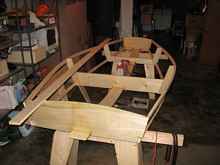 |
Epoxying in the d.b. case |
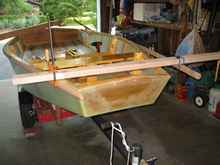 |
Attaching rub rails |
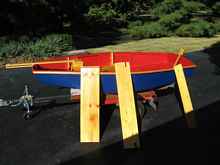 |
D.b. and two removable seats |
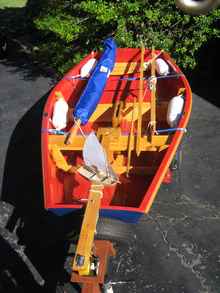 |
Shows the model sitting on the bow sprit. However, it also shows how the bow sprit & mast support blocks are held down with long stainlesss steel bolts with wing nuts. Shows the spars and the fenders which also provide extra floatation. |
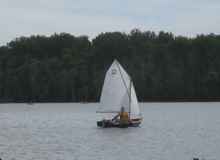 |
Jack sailing solo at Creve Coeur Lake |
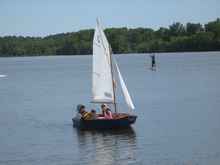 |
Jack with grand daughter at the helm |
I sail on nearby Creve Coeur Lake which is about 330 acres and probably the only natural lake in Missouri. I believe that it was formed from the Missouri River which still overflows into it at high water.
|



